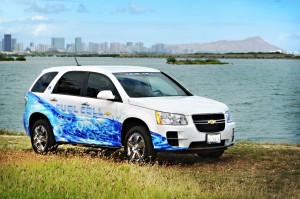
GM is testing the viability of its hydrogen-powered Equinox prototype as part of a Hawaiian pilot program.
Hydrogen is the fuel of the future, goes the old saw, and always will be. A decade ago, hydrogen fuel cell vehicles were being billed as the green power source of choice, but interest has waned, in recent years as emphasis shifts to battery power.
But a new study suggests there’ll be a big market for the clean, lightweight gas, after all. According to Pike Research, there will be at least 5,200 hydrogen fueling stations in operation around the globe by 2020, the result of an estimated $8.4 billion investment effort.
Demand for the fuel is forecast to grow to 418 million kilograms (920 million pounds) annually, compared to 775,000 kilograms (1.7 million pounds) today.
“Currently, the major players in hydrogen fueling are large multinationals: the industrial gas companies, and the energy and gas companies, both those that operate retail gas stations and those that provide fuels for the grid. These companies tend to favor large-scale hydrogen infrastructure options,” explains Pike senior analyst Lisa Jerram.
But she notes that there’s also growing interest in smaller-scale operations. That could permit the use of portable hydrogen storage systems, much like the natural gas canisters available for grills and other applications.
While hydrogen proponents had once hoped to see millions of cars and light trucks on the road using hydrogen to power their fuel cells – or using the gas as an alternative to gasoline in conventional internal combustion engines, as BMW does with its Hydrogen7 – it appears the automotive market might not be fueling the hydrogen market.
The study projects that forklifts will be “the largest driver of hydrogen fuel demand” by decade’s end, consuming about 36% of the gas supply.
Light duty vehicles, which would include automobiles like the Hydrogen7 and the Honda FCX fuel cell vehicle, will account for 33% of total hydrogen usage.
Another big application will be for uninterruptible power supplies, such as for cellphone towers, accounting for 27% of the total. The rest could be used for such things as fuel cell-powered buses and even scooters, according to Pike Research.
Under the Obama Administration, a significant amount of funding previously earmarked for hydrogen vehicle research has been shifted to battery projects. But automakers continue to move forward on developing fuel cells, storage systems and the other necessary technologies. Honda has been leasing small numbers of the FCX in Southern California for several years, while Mercedes-Benz recently began marketing its F-Cell there. GM, meanwhile, is testing a fleet of Chevrolet Equinox fuel cell vehicles as part of a pilot program in Hawaii that uses the state’s abundant geothermal power to produce the gas.
Efforts to commercialize the transportation use of the clean gas have been more aggressive in Europe, especially Germany, which hopes to have several thousand alternative power stations – providing both hydrogen and battery recharging – in place this decade. Iceland, meanwhile, continues to push for fuel cell technology permitting it to shift from imported oil to hydrogen produced using its own geothermal and hydro resources.
